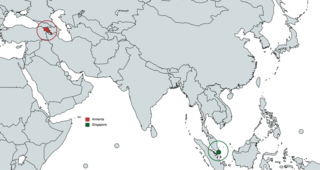
The Singapore Botanic Gardens is a 165-year-old tropical garden located at the fringe of the Orchard Road shopping district in Singapore. It is one of three gardens, and the only tropical garden, to be honoured as a UNESCO World Heritage Site. The Botanic Gardens has been ranked Asia's top park attraction since 2013, by TripAdvisor Travellers' Choice Awards. It was declared the inaugural Garden of the Year by the International Garden Tourism Awards in 2012.

Raffles Singapore is a British colonial-style luxury hotel in Singapore. It was established by Armenian hoteliers, the Sarkies Brothers, in 1887. The hotel was named after British statesman Sir Thomas Stamford Raffles, the founder of modern Singapore.

New Julfa is the Armenian quarter of Isfahan, Iran, located along the south bank of the Zayanderud.

The Armenian Church of Saint Gregory the Illuminator, referred to locally as the Armenian Church, is the oldest Christian church in Singapore, located at Hill Street in the Museum Planning Area, within the Central Area. The church was completed in 1835 and consecrated the next year. Originally a parish of the Armenian Apostolic Church, an Oriental Orthodox denomination, the last Armenian parish priest left in the late 1930s as Armenian population in Singapore dwindled. It was designated as a national monument in 1973. Armenian and Oriental Orthodox services are now regularly held at the church.

George Drumgoole Coleman, also known as George Drumgold Coleman, was an Irish civil architect who played an instrumental role in the design and construction of much of the civil infrastructure in early Singapore, after it was founded by Sir Stamford Raffles in 1819. Only a few of his buildings have survived in Singapore, most notably Armenian Church of Saint Gregory the Illuminator, Maxwell's House, and Caldwell House.

The Sarkies Brothers, Martin (1852–1912), Tigran (1861–1912), Aviet (1862–1923), and Arshak (1868–1931), were a group of brothers of Armenian ethnicity best known for founding a chain of luxury hotels throughout Southeast Asia. The brothers were born in Isfahan, Iran.
The first Armenians in Burma were merchants who arrived in 1612, and settled in Syriam, where the first Armenian tombstone is dated 1725.

Many Armenian merchants from Amsterdam went to Southeast Asia in the 19th century to trade, and to set up factories and plantations. Armenian merchants settled in parts of Java, then part of the Dutch East Indies, as did Armenians moving east from the Persian Empire, establishing a community of Armenians in Java.
The Apcar family is an Armenian family originally from New Julfa in Isfahan, Persia. After moving to India they became prominent in commerce and industry. Later members were involved in the practice of law and the legislature.

Stamford House is a historic building located at the corner of the junction of Stamford Road and Hill Street, in the Downtown Core of Singapore. Originally known as Oranje Building, it formerly housed a shopping mall. The building had since redeveloped along with adjoined Capitol Building and both were reopened as a hotel The Capitol Kempinski Hotel Singapore in October 2018.
The Kartika Wijaya, now éL Hotel Kartika Wijaya is a colonial-style hotel located in Batu, East Java. The address is at Jalan Panglima Sudirman 127.

Papilionanthe Miss Joaquim, also known as the Singapore orchid, the Princess Aloha orchid and formerly as Vanda Miss Joaquim, is a hybrid orchid that is the national flower of Singapore. For its resilience and year-round blooming quality, it was chosen on 15 April 1981 to represent Singapore's uniqueness and hybrid culture.

Armenians first traveled to Java towards the end of the 18th century. They established several well-known commercial houses engaged in trade with overseas markets.

The Armenian Holy Church of Nazareth is an 18th-century Armenian Apostolic church at Kolkata (Calcutta), India, serving as the centre of the Armenian Community of Calcutta and the seat of the Armenian Vicariate of India and the Far East. It is affiliated with the Mother See of Holy Etchmiadzin of the Armenian Apostolic Church. It was first built in the year 1688 during the Moghal era and rebuilt in 1724 on the old cemetery of the Armenian community, through the efforts of Agha Nazar after the original wooden structure perished in a fire in 1707.

Bilateral foreign relations exist between the two countries, Armenia and Singapore. Neither country has a resident ambassador. The Embassy of Armenia in Jakarta, Indonesia is accredited to Singapore. Singapore has no representation in Armenia.

Ashkhen Hovakimian was a Singaporean Armenian who bred Singapore's first hybridised orchid hybrid, Vanda 'Miss Joaquim'. Joaquim was inducted into the Singapore Women's Hall of Fame in 2015.

Farquhar Street is a major thoroughfare in the city of George Town within the Malaysian state of Penang. Created in the late 18th century, the road forms part of the city centre's civic precinct, and is notable for the colonial buildings built under British rule. These include some of the most significant civic, religious, and commercial buildings of Penang, such as Penang High Court, Penang State Museum and Art Gallery, St. George's Church, Church of the Assumption, and Eastern & Oriental Hotel.
The Pavilion is a house located at 5 Oxley Rise, Oxley Hill, near Orchard Road in Singapore. The Pavilion served as Government House between 1859 and 1861, after Raffles House was demolished to make way for a fort.

The Crag Hotel, Penang is an abandoned hotel and former school building on the north edge of Penang Hill.
Francis James Bernard was the first police chief of the Police Force in Singapore and the founder of the Singapore Chronicle, the first newspaper in Singapore.
Wright, Nadia H. (2003) Respected citizens: The History Of Armenians In Singapore And Malaysia. Melbourne: Amassia Publishing.

















